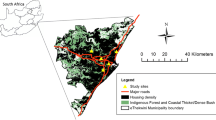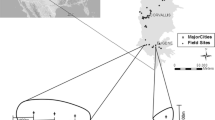Abstract
The effects of landscape patchiness on the diversity of birds of the Georgia Piedmont were investigated during 1993. Birds were sampled along line transects within relatively large (10–13.25 ha) and small (less than 3.25 ha) forest patches located within nonforest agricultural landscapes. Patterns of habitat use in these patches were compared to those in contiguous forest patches larger than 13.25 ha. Analysis of variance revealed significant differences in diversity between large and small woodlots and between contiguous and fragmented landscapes, especially in terms of the numbers of edge and interior species and winter-resident, summer-resident, and year-round birds observed.
Similar content being viewed by others
References
Ambuel, B. and Temple, S.A. 1983. Area-dependent changes in the bird communities and vegetation of southern Wisconsin forests. Ecology 64: 1057–1068.
American Ornithologists' Union. 1983. Check-list of North American Birds, 6th ed. Allen Press Inc., Lawrence, Kansas.
Balent, G. and Courtiade, B. 1992. Modelling bird communities/landscape patterns relationships in a rural area of South-Western France. Landscape Ecol. 6: 195–211.
Blake, J.G. and Karr, J.R. 1984. Species composition of bird communities and the conservation benefit of large versus small forests. Biol. Conserv. 30: 173–187.
Blake, J.G. and Karr, J.R. 1987. Breeding birds of isolated woodlots: Area and habitat relationships. Ecology 68: 1742–1734.
Brittingham, M.C. and Temple, S.A. 1983. Have cowbirds caused forest songbirds to decline? BioScience 33: 31–35.
Burleigh, T.D. 1958. Georgia Birds. University of Oklahoma Press, Norman.
Derleth, E.L., McAuley, D.G. and Dwyer, T.J. 1989. Avian community response to small-scale habitat disturbance in Maine. Can. J. Zool. 67: 382–390.
Dickson, J.G. 1988. Bird communities in oak-gum-cypress forests. In Bird Conservation, Vol. 3. pp. 51–62. Edited by J.A. Jackson. University of Wisconsin Press, Madison.
Ehrlich, P.R., Dobkin, D.S. and Wheye, D. 1988. The Birder's Handbook: A Field Guide to the Natural History of North American Birds. Simon and Schuster Inc., New York.
Farrand, J. (ed.) 1989. The Audubon Society Master Guide to Birding. Alfred A. Knopf, Inc., New York.
Forman, R.T.T. and Godron, M. 1986. Landscape Ecology. John Wiley and Sons, New York.
Freeman, K.E. and Merriam, H.G. 1986. Importance of area and habitat heterogeneity to bird assemblages in temperate forest fragments. Biol. Conserv. 36: 115–141.
Gates, J.E. and Gysel, L.E. 1978. Avian nest dispersion and fledging success in field-forest ecotones. Ecology 59: 871–883.
Hamel, P.B., Legrand, H.E., Lennartz, M.R. and Gauthreaux, S.A. Jr. 1982. Bird habitat relationships on southeastern forest lands. In U.S. Dep. Agric. For. Serv., Gen. Tech. Rep. SE-22.
Hill, M.O. 1973. Diversity and evenness: A unifying notation and its consequences. Ecology 54: 427–432.
Hurst, E., Hehnke, M. and Goude, C.C. 1980. The destruction of riparian vegetation and its impact on the avian wildlife in the Sacramento River Valley, California. Am. Birds 34: 8–14.
Kendeigh, S.C. 1944. Measurement of bird populations. Ecol. Monogr. 14: 67–106.
Kroodsma, R.L. 1982. Edge effect on breeding forest birds along a power-line corridor. J. Appl. Ecol. 19: 361–370.
Kroodsma, R.L. 1984. Effect of edge on breeding forest bird species. Wilson Bull. 96: 426–436.
Pearson, S.M. 1993. The spatial extent and relative influence of landscape-level factors on wintering bird populations. Landscape Ecol. 8: 3–18.
Pulliam, H.R. 1988. Sources, sinks, and population regulation. Am. Nat. 132: 652–661.
Raivio, S. and Haila, Y. 1990. Bird assemblages in silvicultural habitat mosaics in southern Finland during the breeding season. Ornis Fenn. 67: 73–83.
Robbins, C.S. 1978. Census techniques for forest birds. In U.S. Dep. Agric. For. Serv., Gen. Tech. Rep. SE-14.
Robbins, C.S. 1980. Effect of forest fragmentation on bird populations in the piedmont of the Mid-Atlantic region. Am. Nat. 33: 31–36.
Shannon, C.E. and Weaver, W. 1949. The mathematical theory of communication. University of Illinois Press, Urbana.
Simpson, E.H. 1949. Measurement of diversity. Nature, Lond. 163: 688.
Sokal, R.R. and Rohlf, F.J. 1981. Biometry: The Principles and Practice of Statistics in Biological Research (2nd ed.). W.H. Freeman and Co., New York.
Stauffer, D.F. and Best, L.B. 1980. Habitat selection by birds of riparian communities: Evaluating effects of habitat alterations. J. Wildl. Mgmt. 44: 1–15.
Watts, B.D. 1991. Relationship between vegetative cover and the spatial dynamics of Sparrow assemblages in winter landscapes. Ph.D. Diss., University of Georgia, Athens.
Wiens, J.A. 1989. The Ecology of Bird Communities. Cambridge University Press, Cambridge.
Wight, H.M. 1938. Field and Laboratory Technic [sic] in Wild-life Management. University of Michigan Press, Ann Arbor.
Wilcove, D.S. 1985. Forest fragmentation and the decline of migratory songbirds. Ph.D. Diss., Princeton University.
Wilcove, D.S. and Robinson, S.K. 1990. The impact of forest fragmentation on bird communities in eastern North America. In Biogeography and Ecology of Forest Bird Communities, pp. 319–331. Edited by A. Keast. SPB Academic Publishers, The Hague.
Author information
Authors and Affiliations
Rights and permissions
About this article
Cite this article
McIntyre, N.E. Effects of forest patch size on avian diversity. Landscape Ecol 10, 85–99 (1995). https://doi.org/10.1007/BF00153826
Issue Date:
DOI: https://doi.org/10.1007/BF00153826




